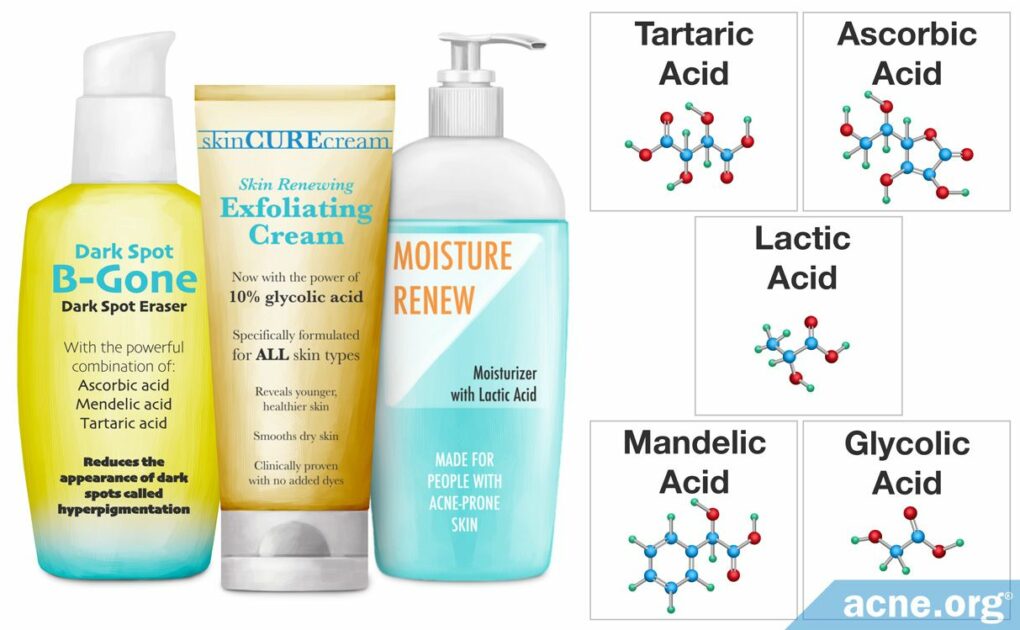Alpha Hydroxy Acids Are Acids That Exfoliate the Skin, Decrease Sebum (Skin Oil), Reduce Bacteria, Decrease Hyperpigmentation, and Promote the Penetration of Other Acne Medications

The Essential Info
Alpha hydroxy acids (AHAs) are topically applied acids that treat a variety of skin conditions, including acne.
They work by:
- Exfoliating the top layer of skin
- Decreasing skin oil production
- Reducing bacteria
- Decreasing hyperpigmentation
- Promoting the penetration of other acne medications
- (unrelated to acne) Reducing signs of skin aging
Over-the-counter AHAs: Alpha hydroxy acids at concentrations of 10% or less are found in over-the-counter treatments for acne.
High-concentration AHAs: Higher concentrations, from 10 – 70%, must be applied by an esthetician/cosmetician, nurse, or doctor, usually in the form of a chemical peel.
Side Effects: The side effects of over-the-counter AHAs are generally mild, including a mild stinging, burning, and itching. Higher concentrations can cause more severe side effects.
Examples of widely-used AHAs: Glycolic acid, lactic acid, mandelic acid

The Science
- Introduction to AHAs
- Types of AHA Used to Treat Acne
- How AHAs Help With Acne
- AHA Treatments for Acne
- Characteristics That Affect the Strength of an AHA Product
- Side Effects of AHAs
- According to the FDA: AHAs Do Not Cause Cancer
- How Well AHAs Work to Clear Acne
Introduction to AHAs
Alpha hydroxy acids (AHAs) are a group of acids used to treat skin diseases like acne, ichthyosis, keratosis, warts, psoriasis, and sun-damaged skin. Although AHAs are naturally found in fruits and milk, the ones used to treat skin diseases are synthetically created in the laboratory.
AHAs can be used at concentrations ranging from 2 – 70% to treat acne. They are effective at clearing and preventing acne to some degree but are most effective when used in combination with other acne medications instead of as a stand-alone treatment.1,2
Types of AHA Used to Treat Acne
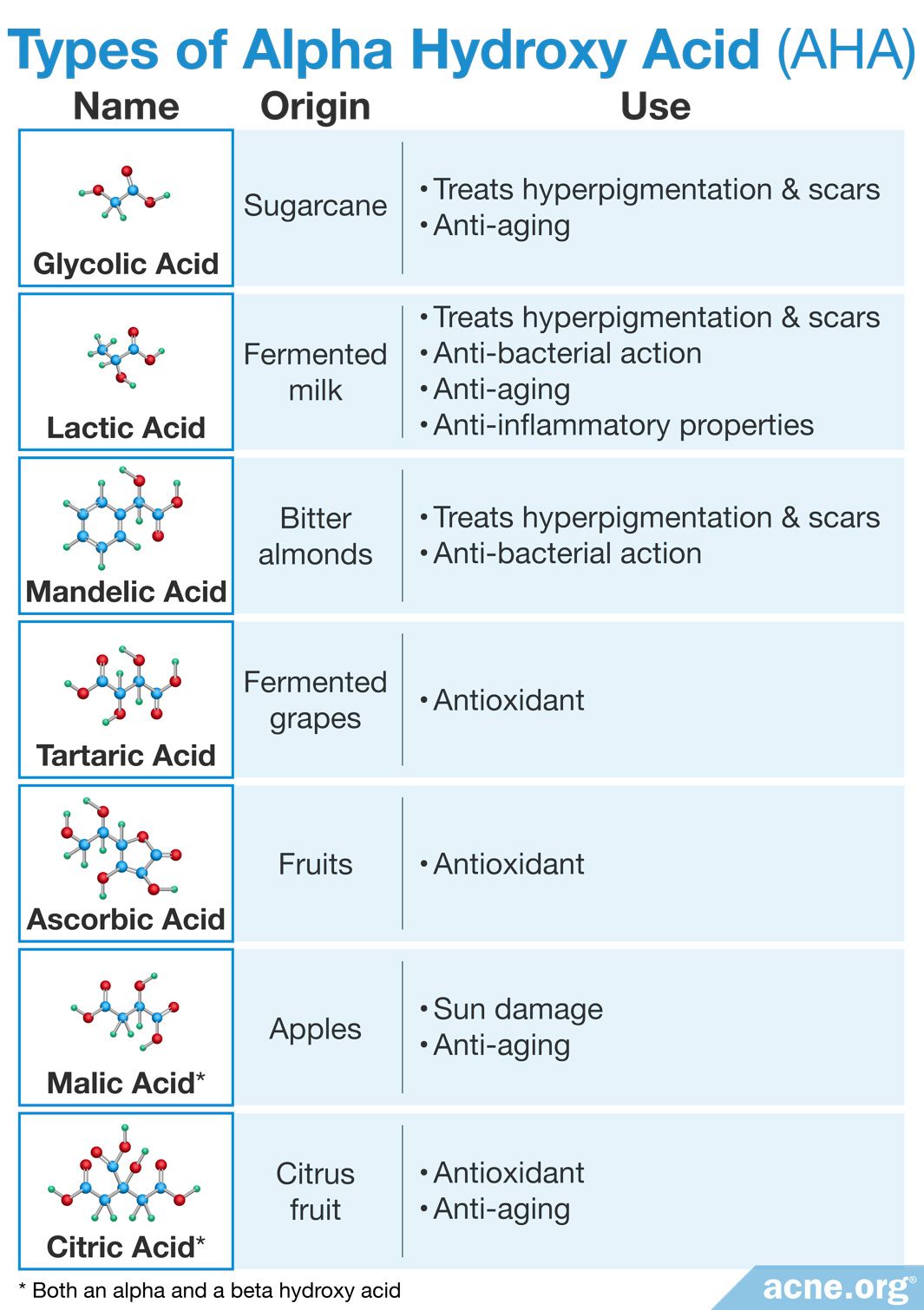
There are several AHAs used to treat acne, including glycolic acid, lactic acid, mandelic acid, tartaric acid, ascorbic acid, malic acid, and citric acid. Glycolic acid is the most common AHA used for the treatment of skin diseases because it was the first AHA scientists discovered, has the most scientific evidence behind it, and is easy to produce. Lactic acid was the second AHA scientists discovered, and it is also a commonly used AHA. The other AHAs tend to be less common.1
How AHAs Help With Acne
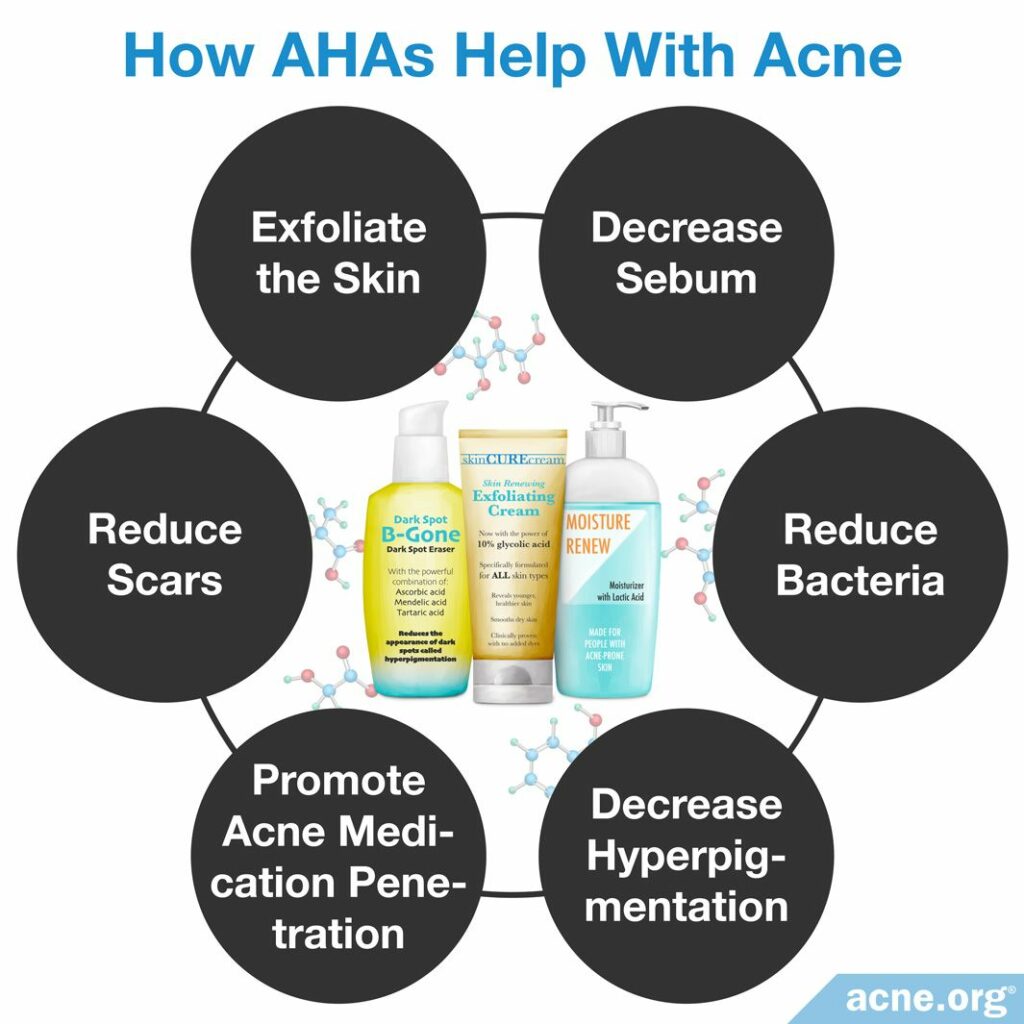
AHAs work in a myriad of ways to help reduce acne, fade the red/dark spots left behind after an acne lesion heals, and reduce acne scarring.
Here’s how:
- Exfoliates the skin: The accumulation of dead skin cells on the surface of the skin leads to clogged pores and acne. Exfoliation of the skin can thin this layer of dead skin cells, which can help unclog pores that would otherwise develop into clogged pores and ultimately acne lesions. Alpha hydroxy acids work to exfoliate the skin by:
- Absorbing calcium: Alpha hydroxy acids can capture calcium particles. Calcium is an important mineral that binds to proteins on the surface of skin cells and helps those cells to attach to other cells. Alpha hydroxy acids can absorb this calcium so that it cannot bind to skin cells. This weakens the connections between skin cells, and this helps to exfoliate the skin.
- Breaking down keratin: Skin cells known as keratinocytes produce a “sticky” protein, called keratin. Keratin causes skin cells to stick together, and this results in them accumulating on the surface of the skin. Acne-prone individuals often produce more keratinocytes than non-acne-prone individuals, and this leads to more keratin and thus clogged pores and acne. Alpha hydroxy acids can break down keratin and “pull apart” skin cells that are stuck together, and this helps clear accumulated cells from the surface of the skin.
- Breaking down surface skin cells: Corneocytes are a type of skin cell that makes up the topmost layer of skin, called the stratum corneum. Alpha hydroxy acids promote the breakdown of corneocytes, and therefore promote the removal of the top layer of skin. Removing the corneocytes helps to exfoliate the skin, resulting in fewer clogged pores and less acne.
- Decreases skin oil: Healthy skin produces skin oil, called sebum, that helps to keep the skin healthy and protected. Acne-prone individuals often produce too much sebum, which can accumulate inside of a clogged pore and cause acne. Alpha hydroxy acids can decrease the amount of sebum the skin produces, which would help to prevent the formation of clogged pores.
- Reduces bacteria: A bacteria called C. acnes thrives inside a clogged pore and can rapidly grow inside an acne lesion. This bacteria can make acne worse by recruiting inflammatory molecules that can make the lesion red, swollen, and sore. This bacteria can also trigger the development of pus. Alpha hydroxy acids possess anti-bacterial properties, meaning that they can decrease the amount of C. acnes inside acne lesions.
- Decreases hyperpigmentation: After an acne lesion heals, it leaves behind red/dark marks. Dermatologists call these marks post-inflammatory hyperpigmentation, or just hyperpigmentation for short. Hyperpigmentation is more common in people with non-Caucasian skin. Alpha hydroxy acids can decrease hyperpigmentation by promoting the growth of new skin cells. Skin discoloration decreases because new skin cells rapidly replace the old, discolored cells, which evens out the color of the skin.
- Promotes penetration of acne medications: To be effective at clearing acne, topical acne medications need to penetrate into the skin. A layer of accumulated dead skin cells covering the skin’s surface can prevent medications from penetrating into the skin, which would reduce their effectiveness. Alpha hydroxy acids exfoliate the topmost layer of skin, and this allows for other topical acne medications to seep into the skin more easily, improving their effectiveness.
- Reduces scars: Severe acne lesions often leave behind scars. High-percentage alpha hydroxy acid peels are sometimes used to reduce scarring from acne lesions.
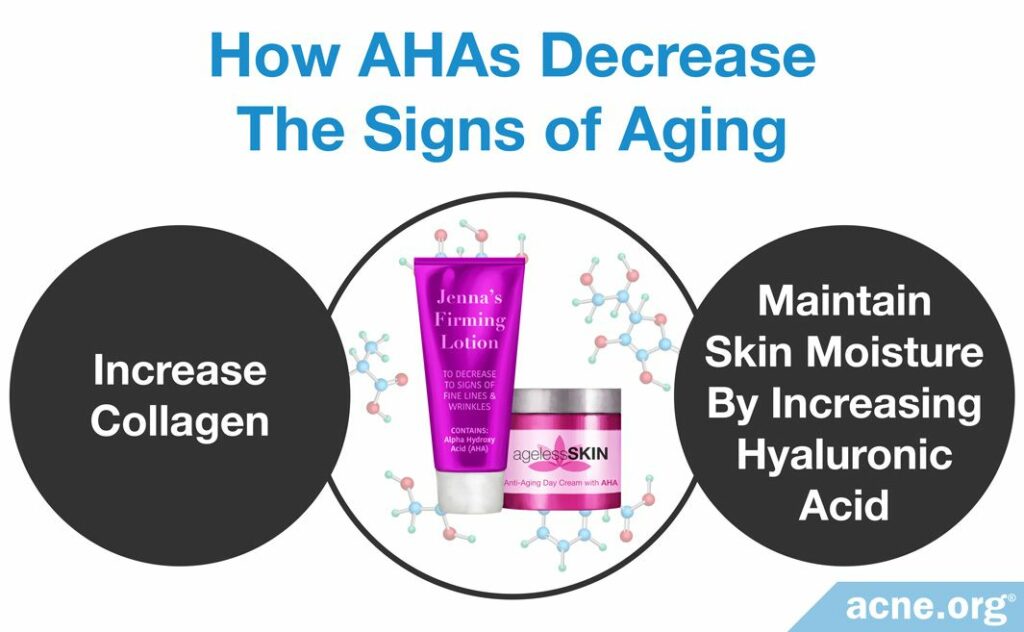
AHAs also decrease the signs of aging.
Here’s how:
- Plumps and hydrates the skin
- Skin thickening: In healthy skin, collagen provides support and structure to the skin. If this collagen is damaged, or if the amount of collagen decreases, wrinkles form. Alpha hydroxy acids can increase the amount of collagen, which would help the skin maintain its shape and strength.
- Skin hydration: Healthy skin must contain a certain amount of water, and without a proper level of water, it can become dry and flaky. This dryness can lead to skin damage and skin aging. Alpha hydroxy acids work to maintain skin moisture by increasing the production of a compound called hyaluronic acid. Hyaluronic acid supports skin hydration, and the increase in moisture improves “skin appearance, texture, and function.”1,3-9
AHA Treatments for Acne
Alpha hydroxy acids are available as:
- Over-the-counter products
- Professionally-administered chemical peels
Over-the-counter products
Over-the-counter products contain glycolic acid at concentrations less than 10%.
These products work similarly to professionally-administered peels, helping to remove the top layer of skin and opening clogged pores. Due to the lower concentration, these products are safe to use at home, and while they can clear acne to some degree on their own, they are most effective when used alongside other acne medications.
Professionally-administered peels
Alpha hydroxy acids, most often glycolic acid, can also be applied in 20 – 70% strength in the form of a professionally-administered chemical peel.
A chemical peel is a substance applied topically onto the skin of the face and/or neck, and allowed to sit for a period of time, usually only a few minutes, before it is removed from the skin. These higher-strength peels must be administered by a professional, such as an esthetician/cosmetician, nurse, or doctor, and should never be attempted at home. An AHA chemical peel, regardless of strength, works by:
- Exfoliating the skin: Alpha hydroxy acid chemical peels exfoliate the top layer of skin, which helps unclog pores.
- Removing keratin plugs: Alpha hydroxy acids can break down the “sticky” protein keratin, thus helping to unclog the opening of the pore. The formation of a keratin plug can lead to acne, so removing keratin plugs can help prevent acne in the first place.
- Removing the contents of an acne lesion: Removing a keratin plug enables the release of the contents of the lesion.
Professionally-administered chemical peels are most effective for clearing acne in people with mild-to-moderate acne. Generally, chemical peels are thought to be ineffective for people with more severe forms of acne, including patients who present with several acne nodules and/or acne cysts.3,4,6
Characteristics That Affect the Strength of an AHA Product
When using AHAs to treat acne, there are two factors that can alter their strength:
- Concentration
- pH (how acidic)
Concentration
- Lower concentration – Over-the-counter products
Generally, AHAs at concentrations up to 10% are safe for more frequent use and light exfoliation of the skin. These concentrations are often found in topical medications or over-the-counter products for daily exfoliation. - Higher concentration – Professionally-administered peels
Only professionals should administer AHAs at concentrations ranging from 20 – 70%. Alpha hydroxy acids at these high concentrations are most often used for deep chemical exfoliation and should never be applied at home.7
pH
pH is a scientific unit that measures the acidity of a compound. The pH scale ranges from 1 – 14, with “1” representing the most acidic substance and “14” representing the least acidic substance. For example, stomach acid has a pH of 2; water has a neutral pH of 7, and bleach has a pH of 12. The pH of an AHA can impact what effects it has on the skin and on acne. The lower the pH, the more effective the AHA is at clearing acne.8 However, a low pH also causes more side effects.
- Higher pH – Over-the-counter products
The U.S. Food and Drug Administration (FDA) has determined that AHAs used for the over-the-counter treatment of acne must have a pH of 3.5 or greater - Lower pH – Professionally-administered peels
Chemical peels performed by a skin care professional can have a pH of 2 or lower, making them more likely to cause severe side effects7
Side Effects of AHAs
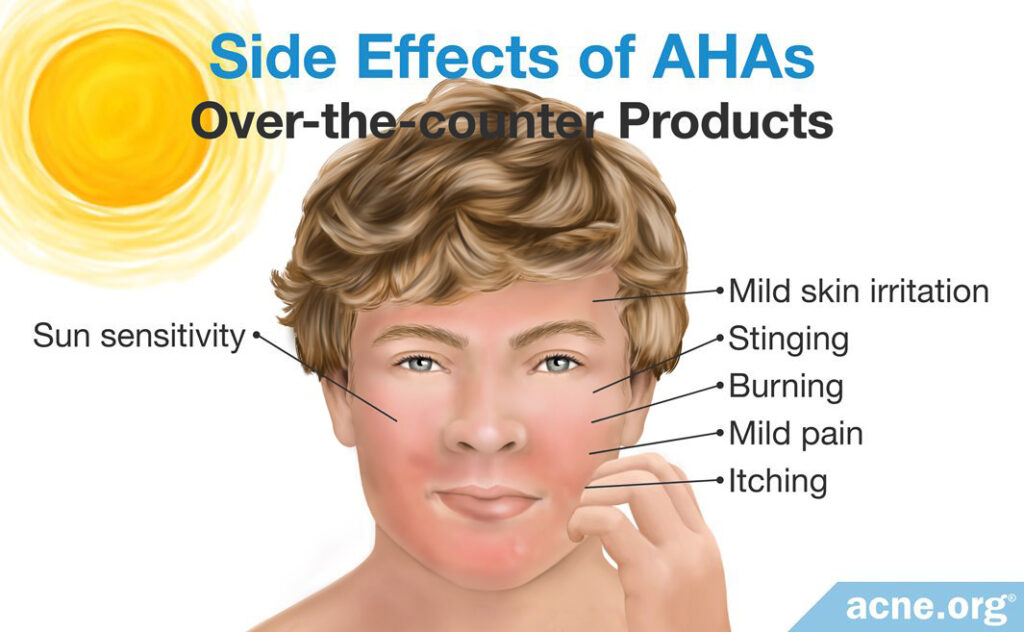
Side Effects of Over-the-counter products
The side effects of AHA products available over-the-counter are minor and may include:
- Mild skin irritation
- Stinging
- Burning
- Mild pain
- Itching
Important! Sun sensitivity: Since AHAs work by removing the top layer of the skin, they make the skin more prone to sunburn. Therefore, it is recommended that those using AHAs always wear some form of sun protection on AHA-treated skin for the entire duration of treatment and for at least one week post-treatment.
Side Effects of Professionally-administered peels
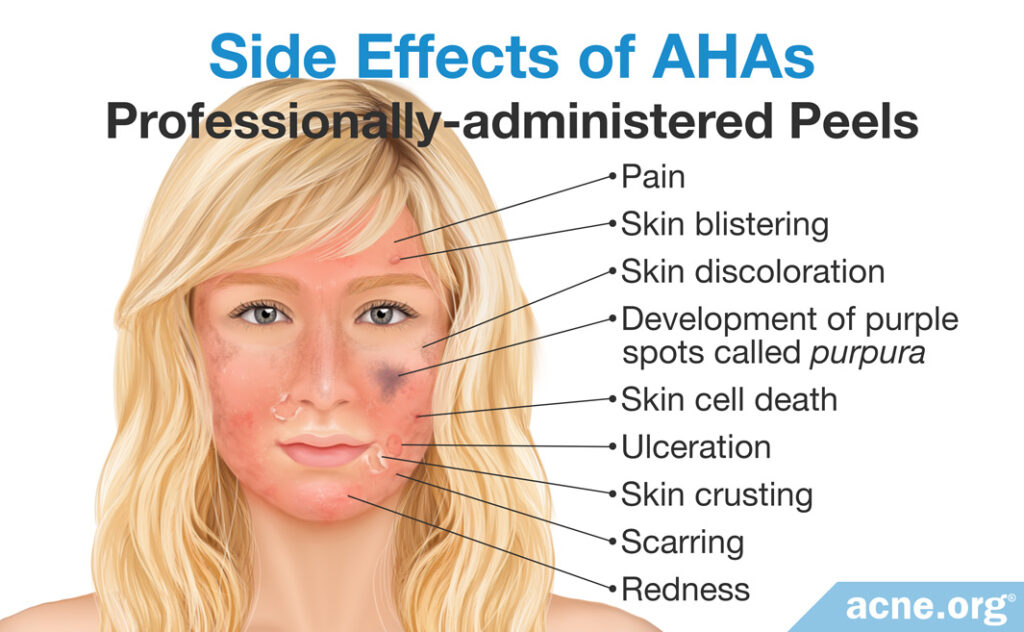
Alpha hydroxy acids at higher concentrations (20 – 70%), especially when incorrectly administered, can cause much more severe side effects, including:
- Pain
- Skin blistering
- Development of purple spots called purpura
- Skin crusting
- Redness
- Skin discoloration
- Skin cell death
- Ulceration
- Scarring
Because these higher-percentage AHA peels cause more severe side effects, only professionals should administer them. If someone were to try a peel at home and something went amiss, major problems could result.
According to the FDA: AHAs Do Not Cause Cancer
Due to AHAs causing an increase in sensitivity to the sun’s rays, several studies have investigated whether they can cause cancer. The Cosmetic Ingredient Review Expert Panel evaluated this evidence in 1998 and concluded, “AHA ingredients are not mutagenic, carcinogenic, are not reproductive or developmental toxins, and are not skin sensitizers.” In other words, AHAs do not cause cancer, do not affect pregnancy, and do not make the skin more sensitive.1,10,11
How Well AHAs Work to Clear Acne
There are several studies investigating the effectiveness of both over-the-counter products and professionally-administered peels on acne.
Expand to read details of study on over-the-counter AHA products
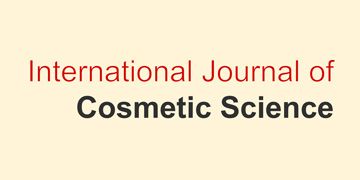
A 2015 study published in the International Journal of Cosmetic Science investigated the effectiveness of a 4% glycolic acid solution at clearing acne in 23 women with facial acne over the course of a 4-week treatment. The researchers found that the 4% glycolic acid treatment reduced non-inflammatory acne lesions, such as whiteheads and blackheads, by 7.6% over 4 weeks.12 It is important to note that this study looked at glycolic acid as a sole treatment. In real life, glycolic acid is often combined with other topical acne treatments to achieve an improved result.
Expand to read details of studies on professionally-administered AHA peels

A 2008 study published in Dermatologic Surgery investigated the effectiveness of a 30% glycolic acid peel at clearing acne in 20 male and female acne patients through the use of 6 peels performed over 12 weeks. This study found that the 30% glycolic acid peel reduced the inflammatory acne lesion (papule and pustule) count by 43%.13

A 2009 study published in Dermatologic Surgery investigated the effectiveness of a 35% glycolic acid peel at clearing acne in 44 male and female acne patients through the use of 6 peels performed over 10 weeks. This study found that the 35% glycolic acid peel reduced the number of inflammatory acne lesions (papules, pustules, nodules, and cysts) by 31% and non-inflammatory acne lesions (whiteheads and blackheads) by 20.9%.14

A 2010 study published in the Journal of Cosmetic Laser Therapy investigated the effectiveness of a 20%, 35%, 50%, and 70% glycolic acid peel at clearing acne in 24 male and female acne patients through the use of 12 peels performed over six months. This study found that the glycolic acid peels reduced the number of inflammatory acne lesions by 29.1% and the number of non-inflammatory acne lesions by 62.7%.15

A 2014 study published in Dermatologic Surgery investigated the effectiveness of a 40% glycolic acid peel at clearing acne in 25 male and female acne patients through the use of 5 peels performed over 10 weeks. This study found that the 40% glycolic acid peel reduced the total number of acne lesions by 74.1%, reducing the number of inflammatory acne lesions by 78.6% and the number of non-inflammatory acne lesions by 69.2%.16

A study published in the journal BMJ Open in 2018 summarized the evidence available to date on AHA-containing chemical peels for treating acne. This study was a systematic review, which means the researchers combed through all the available randomized controlled trials on chemical peels and evaluated them to come to a conclusion. The authors found 12 trials with a total of 387 patients. The trials tested AHAs like glycolic and mandelic acid as well as beta hydroxy acids like salicylic acid. The authors of the review concluded that all commonly used chemical peels were similarly effective at treating mild-to-moderate acne. However, since each trial used slightly different methods, the review authors were unable to compare across all of them to decide which chemical peel might be best.17

Most recently, a study published in the Journal of Cutaneous and Aesthetic Surgery in 2019 compared the efficacy of 3 hydroxy acid peels at treating acne:
- a 35% glycolic acid peel
- a 20% salicylic acid (a beta hydroxy acid) + 10% mandelic acid peel
- a phytic acid peel of unspecified concentration
The researchers randomly assigned 45 male and female acne patients to be treated with one of the 3 chemical peels. The patients received treatment with a chemical peel every other week for 12 weeks, for a total of 6 treatment sessions. At the end of the 12 weeks, the researchers concluded that all 3 chemical peels were equally effective against acne, resulting in a 70-74% improvement in acne on average. They also noted that the chemical peels helped reduce post-inflammatory hyperpigmentation in the patients.18
From this data, we can conclude that over-the-counter AHAs are less effective than professionally-administered peels at clearing acne. However, neither tends to completely clear the skin, so it is often best to combine AHAs with other acne treatments.
References
- Kornhauser, A., Coelho, S. G. & Hearing, V. J. Applications of hydroxy acids: classification, mechanisms, and photoactivity. Clin Cosmet Investig Dermatol 3, 135 – 142 (2010). https://www.ncbi.nlm.nih.gov/pmc/articles/PMC3047947/
- Green, B. A., Yu, R. J. & Van Scott, E. J. Clinical and cosmeceutical uses of hydroxyacids. Clin Dermatol 27, 495 – 501 (2009). https://www.ncbi.nlm.nih.gov/pubmed/19695482
- Kessler, E., Flanagan, K., Chia, C., Rogers, C. & Glaser, D. A. Comparison of α- and β-hydroxy acid chemical peels in the treatment of mild to moderately severe facial acne vulgaris. Dermatol Surg 34, 45 – 51 (2008). https://www.ncbi.nlm.nih.gov/pubmed/18053051
- Araviiskaia, E. & Dréno, B. The role of topical dermocosmetics in acne vulgaris. J Eur Acad Dermatol Venereol 30, 926 – 935 (2016). https://www.ncbi.nlm.nih.gov/pubmed/26916232
- Green, B. After 30 years … the future of hydroxyacids. J Cosmet Dermatol 4, 44 – 45 (2005). https://www.ncbi.nlm.nih.gov/pubmed/17134422
- Dréno, B. et al. Efficacy of superficial chemical peels in active acne management – What can we learn from the literature today? Evidence-based recommendations. J Eur Acad Dermatol Venereol 25, 695 – 704 (2011). https://www.ncbi.nlm.nih.gov/pubmed/21029205
- Babilas, P., Knie, U. & Abels, C. Cosmetic and dermatologic use of alpha hydroxy acids. J Ger Soc Dermatol 10, 488 – 491 (2012). https://www.ncbi.nlm.nih.gov/pubmed/22916351
- Valle-González, E. R., Jackman, J. A., Yoon, B. K., Mokrzecka, N. & Cho, N. J. pH-dependent antibacterial activity of glycolic acid: Implications for anti-acne formulations. Sci Rep 4, 7491-7499 (2020). https://pubmed.ncbi.nlm.nih.gov/32367064/
- Yu, R. J. & Van Scott, E. J. Alpha-hydroxyacids and carboxylic acids. J Cosmet Dermatol 3, 76 – 87 (2004). https://www.ncbi.nlm.nih.gov/pubmed/17147560
- FDA. Alpha-Hydroxy Acids. https://www.fda.gov/cosmetics/productsingredients/ingredients/ucm107940.htm
- Sams, R. et al. Effects of α- and β-Hydroxy acids on the edemal response induced in female SKH-1 mice by simulated solar light. Toxicol Appl Pharmacol 184, 136 – 143 (2002). https://www.ncbi.nlm.nih.gov/pubmed/12460741
- Kim, S. J. et al. The effect of physically applied alpha hydroxyl acids on the skin pore and comedone. Int J Cosmet Sci 37, 519 – 525 (2015). https://www.ncbi.nlm.nih.gov/pubmed/26032934
- Kessler, E., Flanagan, K., Chia, C., Rogers, C. & Glaser, D. A. Comparison of alpha- and beta-hydroxy acid chemical peels in the treatment of mild to moderately severe facial acne vulgaris. Dermatol Surg 34, 45 – 50 (2008). https://www.ncbi.nlm.nih.gov/pubmed/18053051
- Garg, V. K., Sinha, S. & Sarkar, R. Glycolic acid peels versus salicylic-mandelic acid peels in active acne vulgaris and post-acne scarring and hyperpigmentation: a comparative study. Dermatol Surg 35, 59 – 65 (2009). https://www.ncbi.nlm.nih.gov/pubmed/19076192
- Ilknur, T., Demirtaşoğlu, M., Biçak, M. U. & Ozkan, S. Glycolic acid peels versus amino fruit acid peels for acne. J Cosmet Laser Ther 12, 242 – 5 (2010). https://www.ncbi.nlm.nih.gov/pubmed/20825257
- Kaminaka, C., Uede, M., Matsunaka, H., Furukawa, F. & Yamomoto, Y. Clinical evaluation of glycolic acid chemical peeling in patients with acne vulgaris: a randomized, double-blind, placebo-controlled, split-face comparative study. Dermatol Surg 40, 314 – 22 (2014). https://www.ncbi.nlm.nih.gov/pubmed/24447110
- Chen, X., Wang, S., Yang, M. & Li, L. Chemical peels for acne vulgaris: a systematic review of randomised controlled trials. BMJ Open 8, e019607 (2018). https://www.ncbi.nlm.nih.gov/pubmed/29705755
- Sarkar, R., Ghunawat, S. & Garg, V. K. Comparative study of 35% glycolic acid, 20% salicylic-10% mandelic acid, and phytic acid combination peels in the treatment of active acne and postacne pigmentation. J Cutan Aesthet Surg 12, 158-163 (2019). https://pubmed.ncbi.nlm.nih.gov/31619887/
 Acne.org Products
Acne.org Products